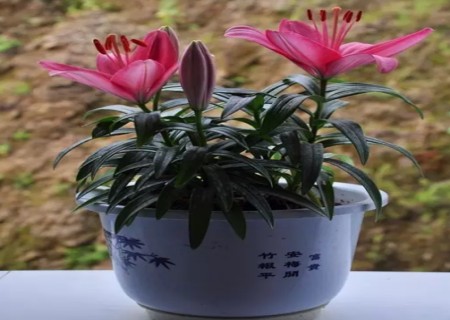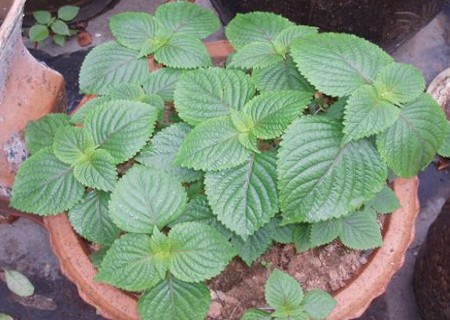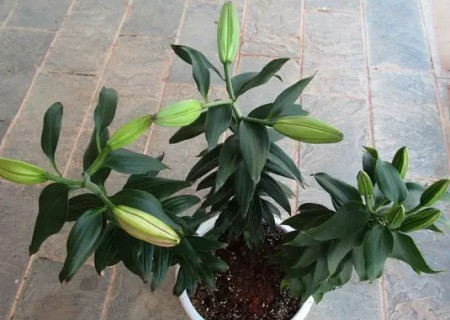Dwarfing Technology of Lily Bonsai
Lily is deeply loved by everyone, and many flower friends are experts in planting and conservation, but some relatives just envy fish in Linyuan and have never even dared to try to grow them. So, I hope this planting point can be discussed with the master and shared with the novice.
The lily is one of the five famous fresh cut flowers with bright color and graceful posture. In recent years, potted lilies have sprung up quietly, which complements the shortcomings of cut lilies. High-quality potted flowers require short, compact plant types, stout stems, leaves and flowers. At present, the plant height of most white lily varieties is 60-120cm, if planted in the basin, the high stem is easy to tilt and break, it is not convenient to transport, the foot leaves are yellow and backward, and the comprehensive ornamental effect is not good.

However, there are few dwarf varieties of lilies, so appropriate dwarfing during pot cultivation and adjusting plant height according to needs can greatly improve the ornamental value, adapt to different market demand and improve economic benefits. The following is to introduce the dwarfing technology of lily bonsai for you.
1. Cultivation substrate
Potted lily requires good matrix permeability, medium fertility, good moisture retention, no miscellaneous bacteria and high salt content. The soil pH6-7 of Asian type lily and the soil pH5.5-6.5of oriental type lily. Substrate composition: 50% peat soil + 30% seedling soil + 20% perlite (or coarse river sand) + a small amount of rice chaff ash.
2. Seed ball selection
Bulbs of different sizes are suitable for potted plants. Choose flowerpots of different sizes and the number of balls in each pot according to the size of the seed ball. Generally, there are 1 10-12cm pot seed, 14-18cm bulb diameter, 3 flowers per pot with 4-8 17cm, 12-16cm bulb diameter, 3-5 seeds per pot with 6-15 25cm, 12-18cm bulb diameter, and 25 flowers per pot with 5 bulbs. Potted lilies should choose full, uniform and disease-free bulbs.
3. Seed ball treatment
The seed balls contaminated by germs should be removed before planting and soaked in 75% chlorothalonil 800 times solution for 30 minutes or 70% methyl thiophanate 800 times solution for 1 hour, picked up and dried and planted in pots.
2. Planting process
First put a layer of large-grained soil mass at the bottom of the flowerpot, and then spread the matrix prepared by 1-2cm, and put in the seed ball to make the basal root stretch and lay flat (be careful not to cut off the basal root, which can remove the necrotic old root). The seed ball of one pot and one ball is placed in the middle of the basin with the bud facing up. Uniform discharge of many balls in a pot, buds slightly toward the basin wall (to avoid squeezing in the middle after budding), and then cover the bulb with soil 6-8cm (planted in winter) or 8-10cm (planted in summer). Because the lily mainly relies on stem roots to absorb water and nutrients during the growth period, the soil cover must not be too shallow, otherwise the adventitious roots of the stem nodes will not grow well, which will eventually affect the growth of lilies and are easy to lodge. After covering the soil, compact the soil slightly, put it in the shade shed, put it neatly at a certain interval, not too dense, and water it thoroughly.
3. Dwarfing treatment
When 5-10cm was unearthed from potted lily buds, paclobutrazol was applied to the soil. The results showed that the height of lily could be controlled at 20-25cm / 100mg / L by paclobutrazol of 150mg/L and the height of lily at 25-30cm / 50mg / L, and the height of lily could be controlled at about 35cm. As long as the timing of application is grasped, the effect can be achieved only once. The application of paclobutrazol could dwarf potted lily, compact plant type, deepen leaf color and reduce foot leaf yellowing, but had no effect on the number and size of flowers and leaves, and could obviously improve the ornamental effect of potted lily.
Lily has strong adaptability and lax requirements on soil quality, and grows best in a cool, dry and sunny environment. However, the lily plant is higher, generally about 70 cm to 120 cm, and the basic leaves of the plant are often too high, the whole plant is not coordinated, which affects the ornamental value. Lily dwarfing cultivation should follow the principle of "three choices and three treatments", which is introduced below.
1. Selection and treatment of bulbs.
The planting of lilies usually takes place in autumn. Healthy bulbs that are full, full and pest-free should be selected and soaked in 2% formalin solution for 15 minutes or 70% methyl topiramate 800 times solution for one hour before planting, and can be planted after being taken out and dried.
2. Selection and treatment of matrix.
The matrix should choose sandy loam with good permeability, strong fertility, good water retention, no miscellaneous bacteria and grass seeds, and slightly acidic sandy loam. It can be made of two parts of fertile soil, two parts of fine sand and one part of peat soil, and a small amount of phosphate fertilizer is added. The substrate can be sterilized by exposure, chemical fumigation or pan-frying to kill germs and grass seeds.
3. Selection and treatment of flowerpots.
Flowerpots should choose mud pots with strong air permeability and holes at the bottom. In order to improve the appreciation, plastic pots or porcelain pots can be set. The new basin should be soaked in the 800 times solution of 75% chlorothalonil wettable powder for 30 minutes to kill bacteria and eliminate alkalinity.
In addition, before planting lilies, put some tiles at the bottom of the flowerpot, then put on the soil mass, and then spread the matrix of 4 cm to 6 cm. Plant the bulb in the pot and cover the soil with 5 cm to 8 cm. Do not be too shallow, otherwise the plant is easy to lodge. After covering the soil, compact it slightly, put it in a cool place and pour it with water.
After planting, there are five more points to pay attention to:
1. Dwarfing. When the lily bud is unearthed from 6 cm to 10 cm, apply appropriate amount of paclobutrazol to the soil to control the height of the lily plant and achieve the purpose of dwarfing.
2. Light. Lily likes light, lack of light is easy to cause overgrowth of plants and poor flowering. If you want to make the lily open during the Spring Festival, it is appropriate to choose Chinese and Japanese lilies, and appropriate supplementary light, so that its plants are dwarfed, the flowers are bright, and the leaves are thick green.
3. Temperature. The suitable temperature for the growth of lily is 10 degrees Celsius to 25 degrees Celsius, but it is appropriate to maintain low temperature not more than 13 degrees Celsius after planting to before emergence. After emergence, raise the temperature appropriately and control it at about 22 degrees Celsius during the day. Different kinds of lilies require different temperatures at night, so they should be treated differently and placed separately.
4. Moisture. Lily's growth period and flowering period need more water, it is appropriate to keep the basin soil moist, but avoid stagnant water, in order to prevent rotting roots. If the air is too dry, you can sprinkle water on the leaf surface and the ground to keep the relative humidity at about 70%.
5. Fertilizer. Lily began to be fertilized when the upper leaves of the stem unfolded, and soil topdressing was combined with leaf topdressing, once every 10 to 15 days. It is necessary to apply thin fertilizer frequently and avoid heavy fertilizer, mainly nitrogen fertilizer in the early stage and phosphorus and potassium fertilizer after budding.
Time: 2019-05-24 Click:
- Prev

How to collect seeds and plant potted plants with perilla
Perilla, also known as red perilla and fragrant perilla, has the effect of dispelling cold and relieving the surface, regulating qi and wide chest, calming the lungs and moistening the intestines. It is one of the 60 substances issued by the Ministry of Health for both food and medicine. Perilla leaves have been used as raw materials for fashionable vegetables and health products in Europe, America, Southeast Asia and Hong Kong, Macao and Taiwan in China.
- Next

How to plant lily bulbs-potted lily bulbs planting method illustration
Lily, perennial herb with ornamental flowers and underground bulbs for food, was discovered for food and medicinal use in the 4th century AD. Lily is named lily because of its scale overlap, lily also means good harmony for a hundred years, and lily color elegant, fragrance
Related
- Fuxing push coffee new agricultural production and marketing class: lack of small-scale processing plants
- Jujube rice field leisure farm deep ploughing Yilan for five years to create a space for organic food and play
- Nongyu Farm-A trial of organic papaya for brave women with advanced technology
- Four points for attention in the prevention and control of diseases and insect pests of edible fungi
- How to add nutrient solution to Edible Fungi
- Is there any good way to control edible fungus mites?
- Open Inoculation Technology of Edible Fungi
- Is there any clever way to use fertilizer for edible fungus in winter?
- What agents are used to kill the pathogens of edible fungi in the mushroom shed?
- Rapid drying of Edible Fungi

